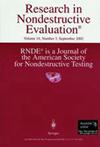Hands-On Training of Non-destructive Testing Using a Mock-Up in the Curriculum of Civil Engineers
IF 1.6
4区 材料科学
Q3 MATERIALS SCIENCE, CHARACTERIZATION & TESTING
引用次数: 1
Abstract
ABSTRACTOur infrastructure deteriorates progressively and the knowledge about the current condition is crucial to enable proper maintenance. Nondestructive techniques provide the basis for reliable condition assessment and thus, requires talented engineers with corresponding skills. Fortunately, in the curriculum of civil engineers, nondestructive testing gains more and more importance. The challenge in teaching nondestructive testing is to fulfil the requirement that students achieve the learning objective of “Application.” The term “Application” describes the ability that students are able to use nondestructive techniques appropriately. This teaching objective is not achievable in classroom lectures. Thus, the authors developed a mock-up for hands-on learning where students can try several nondestructive techniques such as half-cell potential measurement, Radar, ultrasound, impact-echo etc. Civil engineering students often encounter difficulty with the handling of sometimes very sophisticated devices. The challenge increases even more when the students have to extract the measured data, evaluate them, and relate their results to the condition of the tested object. With the support of the mock-up the authors intended to assist civil engineering students to understand the application of nondestructive techniques. This paper presents the design of the mock-up in combination with the corresponding teaching concept and the first teaching experience.KEYWORDS: Mock-upeducationreinforced concreteNDThalf-cell potential measurementradarultrasoundimpact-echoteaching concept AcknowledgmentsThe authors acknowledge the financial support received from the education fund of the Technical University of Munich. The authors also acknowledge assistance from colleagues, laboratory staff, and students from the center of building materials at different stages of the mock-up from the planning until the execution of the measurement, here in alphabetical order: Robin Groschup, Sebastian Lucka, Fabian Malm, Florian Mrowietz, Manuel Raith, and Alejandro Ramirez Pinto [Citation17].Disclosure statementNo potential conflict of interest was reported by the author(s).土木工程师课程中使用实物模型的无损检测实践培训
基础设施逐渐退化,了解当前状况对于进行适当的维护至关重要。无损技术为可靠的状态评估提供了基础,因此需要具有相应技能的优秀工程师。所幸的是,在土木工程课程中,无损检测越来越受到重视。如何使学生达到“应用”的学习目标,是无损检测教学面临的挑战。“应用”一词描述的是学生能够恰当地使用无损技术的能力。这一教学目标在课堂教学中是无法实现的。因此,作者开发了一个动手学习的模型,学生可以尝试几种非破坏性技术,如半电池电位测量,雷达,超声波,冲击回波等。土木工程专业的学生在处理复杂的设备时经常遇到困难。当学生必须提取测量数据,评估它们,并将结果与被测对象的状况联系起来时,挑战就更大了。在实物模型的支持下,作者旨在帮助土木工程专业的学生了解无损技术的应用。本文结合相应的教学理念和第一次教学经验,提出了实物模型的设计。关键词:模拟教育;钢筋混凝土;半细胞电位测量;超声冲击;作者还感谢来自建筑材料中心的同事、实验室工作人员和学生在模型从规划到测量执行的不同阶段提供的帮助,这里按字母顺序排列:Robin Groschup、Sebastian Lucka、Fabian Malm、Florian Mrowietz、Manuel Raith和Alejandro Ramirez Pinto[引文17]。披露声明作者未报告潜在的利益冲突。
本文章由计算机程序翻译,如有差异,请以英文原文为准。
求助全文
约1分钟内获得全文
求助全文
来源期刊

Research in Nondestructive Evaluation
工程技术-材料科学:表征与测试
CiteScore
2.30
自引率
0.00%
发文量
14
审稿时长
>12 weeks
期刊介绍:
Research in Nondestructive Evaluation® is the archival research journal of the American Society for Nondestructive Testing, Inc. RNDE® contains the results of original research in all areas of nondestructive evaluation (NDE). The journal covers experimental and theoretical investigations dealing with the scientific and engineering bases of NDE, its measurement and methodology, and a wide range of applications to materials and structures that relate to the entire life cycle, from manufacture to use and retirement.
Illustrative topics include advances in the underlying science of acoustic, thermal, electrical, magnetic, optical and ionizing radiation techniques and their applications to NDE problems. These problems include the nondestructive characterization of a wide variety of material properties and their degradation in service, nonintrusive sensors for monitoring manufacturing and materials processes, new techniques and combinations of techniques for detecting and characterizing hidden discontinuities and distributed damage in materials, standardization concepts and quantitative approaches for advanced NDE techniques, and long-term continuous monitoring of structures and assemblies. Of particular interest is research which elucidates how to evaluate the effects of imperfect material condition, as quantified by nondestructive measurement, on the functional performance.
 求助内容:
求助内容: 应助结果提醒方式:
应助结果提醒方式:


